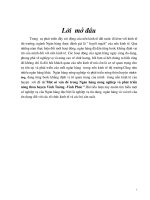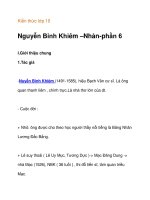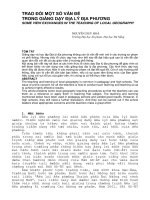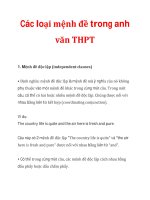Vấn đề trong anh văn8 pps
Bạn đang xem bản rút gọn của tài liệu. Xem và tải ngay bản đầy đủ của tài liệu tại đây (71.19 KB, 6 trang )
sheet with a coordinating set of definitions in a second column along
the right side of the paper. You are then asked to “match” each word
to its proper definition.
Examples
1. Match the words on the left with their proper definitions on the
right:
a. mediocre 1. inelegant
b. gauche 2. complete
c. urbane 3. average
d. consummate 4. elegant
2. Match the words on the left with their proper parts of speech on
the right:
a. the 1. noun
b. of 2. adverb
c. apple 3. verb
d. slowly 4. article
e. ran 5. preposition
How did you do?
Answers
1. a—3, b—1, c—4, and d—2
2. a—4, b—5, c—1, d—2, and e—3
Tips for Answering Matching Questions
• Find out whether each answer is used only once.
Sometimes a teacher will allow the same answer, usually found in
the column on the right side of the page, to be used more than
once. If the directions are not clear about this, be sure to ask the
teacher or instructor. If each answer can only be used once and you
are allowed to write on the test, cross out the letter after you have
used it so that you can see what’s left. If you are not allowed to write
on the test but have a piece of scrap paper, write the answer letters
or numbers on the scrap paper and cross them off there.
Getting a Handle on Objective Testing
19
• Read all the items in both columns before answering any
question.
Knowing all of the possibilities before marking your answers will
cut down on the amount of second-guessing and answer changing
later. Read both columns first, and then begin to mark your
answers. Also, being familiar with the full range of information
being covered on the matching test will allow you to understand
the context of the questions as they relate to the answers.
• Answer the questions you know first.
There is no better way to build confidence than to start off with the
questions for which you are sure of the answers. After you have
familiarized yourself with the information in both columns, begin
with the information that is most familiar to you. Again, if you are
allowed, mark off each answer as you use it. If not, use a piece of
scrap paper to keep track of the answers that you have already used.
STUDY AEROBICS
Test Yourself
When studying for a test with a friend, create your own practice
multiple-choice, true or false, and fill-in-the-blank questions. The
process of creating questions will not only help familiarize you
with the material but will also give you insight into the logic and
construction of objective tests. Make sure your practice questions
are challenging enough to require serious thought. Create chal-
lenging multiple-choice questions by coming up with truly dis-
tracting “distractors” that make the correct answer less obvious.
Create challenging true or false questions by coming up with
statements that are almost true except for one important detail or
seemingly false if read too quickly. Create challenging fill-in-the-
blank questions by writing out complete sentences and then delet-
ing a key word. When you and your friend have both finished
creating your practice exams, exchange them, and see how well
you do.
SENTENCE COMPLETION
In the first two types of objective test questions, you were given the
answers. Now, we move to a type of question where you will be
20
10 SECRETS TO ACING ANY HIGH SCHOOL TEST
expected to provide the answer on your own. Sentence completion
questions may be more stressful to you simply because you will be
forced to recall information rather than to choose the best option that
is provided to you.
When taking a test that includes sentence completion questions, it
is helpful to think about what the instructor or teacher has in mind.
Understanding the context of the sentence can be very helpful in lead-
ing you to the correct answer to fill in the blank. Because the instruc-
tor usually has a specific answer in mind when creating the
fill-in-the-blank questions, sentence completion tests are still consid-
ered objective rather than subjective.
Examples
1. Scientific knowledge is usually _______, often resulting from years
of hard work by numerous investigators.
a. ponderous
b. implacable
c. precarious
d. cumulative
e. egregious
2. Even though _______ meals cause her digestive trouble, my grand-
mother insists on eating her food as _______ as possible.
a. piquant/spicy
b. foreign/often
c. astringent/slowly
d. cold/quickly
e. purgative/daintily
3. The human body has _______ bones.
4. _______ created a cure for rabies.
How did you do?
Answers
1. d.
2. a.
3. 206.
4. Louis Pasteur.
Getting a Handle on Objective Testing
21
Tips for Answering Sentence Completion
(Fill-in-the-Blank) Questions
• If you don’t know the exact answer, come as close as you can.
Even if you do not give the exact word that the teacher wants, you
may come close enough to get partial credit.
• Check the number of blanks.
If the test creator has left more than one blank, chances are that
he or she is looking for more than one word. The converse can-
not always be held true. A single blank may hold a multi-word
answer.
• Look for “a” or “an.”
Knowing basic rules of grammar can help provide hints to the
answer. For example, a word that starts with a vowel should follow
the word “an” in a sentence, whereas a word that starts with a con-
sonant should follow “a.” Also, study the sentence to decide if the
correct answer is singular or plural.
• Test your answer.
After you choose an answer, read the entire sentence to yourself
using your answer in the sentence. If the sentence sounds clumsy,
you may have answered incorrectly. If the sentence sounds familiar,
you should feel more confident.
TRUE OR FALSE
True or false questions usually give you the best odds of answering
correctly, but they are often the trickiest of the objective test ques-
tions. It is very important that you take the time to read the question
completely, understanding each piece of the sentence or sentences
that make it up.
Examples
_____ 1. At the 1932 Democratic National Convention, Franklin D.
Roosevelt, the 34th president of the United States, said “I pledge you,
I pledge myself, to a new deal for the American people.”
_____ 2. The 15th amendment to the Constitution prohibits federal
or state governments from infringing on citizens’ right to vote,
regardless of their race, color, or previous condition of servitude.
22
10 SECRETS TO ACING ANY HIGH SCHOOL TEST
How did you do?
Answers
1. False. The quote is, in fact, attributed to Franklin D. Roosevelt,
but he was the 32nd president of the United States, not the 34th.
2. True.
Tips for Answering True or False Questions
• Watch out for absolutes.
Look for absolutes or all-or-nothing words like always, never, and
entirely. There are very few things in life that are always true or
always false. Questions that contain these words are often false.
• It’s either all true or all false.
Be sure that all pieces of the statement are correct before marking
an answer true. In the example, “Germany, a country in Asia, is
home to the Autobahn,” only part of the statement is true. Ger-
many is home to the Autobahn, but it is not a country in Asia. If any
part of the statement is wrong, the whole thing is false.
• Don’t overanalyze.
Read the statement as it is written, without adding any of your own
thoughts or ideas to what appears on the test. Sometimes students
who are already nervous about the test will overanalyze a true or
false question. When they do this, they either answer the question
incorrectly or confuse themselves further and end up wasting time.
It is imperative that you read the statement exactly as it appears.
• Know your teacher.
Ideally, you will never have to rely on this tip, but when it comes to
true or false questions, it may help you to know your teacher. It has
been shown on teacher-created tests and quizzes that teachers often
create more of one type of question than another. Some teachers
have shown patterns of creating more questions with false answers,
whereas others have shown a tendency to create more with true
answers. If possible, look over some of your past tests to predict
your teacher’s tendencies. If you are unsure of your teacher’s pat-
terns, it is best to guess “true,” because more teachers have the ten-
dency to create true answers than false.
Getting a Handle on Objective Testing
23
GRID-IN
Grid-in questions are also referred to as student-produced responses. The
SAT exam has 10 grid-in questions, and some state exit exams have
this type of question as well. Basically, you will be asked to solve a
variety of math problems and then fill in the correct numbered ovals
on your answer sheet. Again, the key to success with these problems
is to think through them logically; that’s easier than it may seem to
you right now.
Examples
1. Tia is buying a shirt that regularly sells for $36.00 but is now on
sale for $23.40. By what percent of the regular price has this shirt
been discounted?
2. What is the next number in this sequence? Round your answer to
the nearest thousandth. 8, 3.2, 1.28, 0.512, ___
24
10 SECRETS TO ACING ANY HIGH SCHOOL TEST









